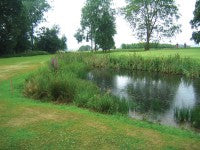Be Wise, Economise
 The golf industry has to deal with the economic recession just like any other business and, in order to come out the right side of this unfortunate slump, it may be wise to economise.
The golf industry has to deal with the economic recession just like any other business and, in order to come out the right side of this unfortunate slump, it may be wise to economise.
Economising on the course can be used to showcase practical solutions, for example, stepping back from intensive management practices to site specific and more natural management techniques. Whilst this may sound odd in an article about economising, it may be worth spending money on a good scientific agronomist who understands a club's budget in order to get the most out of changes in practice.
Transforming the golf club towards a more environmentally friendly managed course, whilst helping to save some cash will also inspire locals and golfers alike. This is a great way to utilise its influence on society and, indeed, on the industry.
The recent shift in thinking from bigger and better to 'ECOnomise and be wise' is generating a level of optimism for greening the golf game. Up until now, we have been running away with ourselves in terms of design and management.
Importing banana trees from halfway around the world to enhance our round of golf, just to give a course a unique selling point is, clearly, unstable thinking. We really should revert to protecting what we already have - our own native species and natural environment. Why not plant an oak or a beech instead? And, while you're at it, erect a few bird boxes as well! Not only are native species already adapted to the local environment they also perform better and require less maintenance than more exotic non-native species.
Not only does a golf course have the potential to act as a showcase for environmental protection it can also use this as branding for its own benefit. The tourist golfer (and indeed the local golfer) would, in my opinion, savour the local environs of native species and landscapes rather than coming across more exotic, intensively managed areas on their round. Of course, greens in good condition will always be required and these can be achieved with site specific management and good cultural practices.
By protecting and enhancing ecosystems and biodiversity, maximising resource use, reducing and optimising waste management on site, along with conserving cultural heritage and the green landscape, a unique brand can be configured.
Clever branding of environmental principles and management practices on the course will also facilitate much needed golf tourism and may boost local golf too. It is realistic to link 'eco' with 'economise' - after all it does make up the first three letters of the word! It is no coincidence that many environmentally friendly management practices are also friendly on the wallet.
A good place to start is to make 'eco' part of the management policy; to clean up ponds, rejuvenate untidy areas, use local employment and, of course, local produce. Shop around for good scientific agronomic advice and consultants that offer value for money as well as expertise and fresh thinking. Keeping on a good consultant will help steer you in the right direction and avoid costly long term mistakes in both the design and management of the course. A good consultant will help you plan, prepare and position the golf course for the future, according to your specific budget and requirements.
Many courses rely on blanket applications of chemicals, pesticides and other chemicals to maintain the turf to a particular standard. Switching to more eco-friendly management practices (for example, targeted or spot applications of chemicals, using organic fertilisers, forgetting about calendar applications of materials etc.) will mean that golfers and wildlife alike will be exposed to fewer pesticides and less health hazards whilst, at the same time, cutting maintenance costs.
The golf course can also be a large user of resources such as water. It may be beneficial to devise management strategies to decrease water use (targeted watering, monitored systems, use of mulch around shrubs and trees etc.). It is also worth carrying out research into using 'grey' water on site.
Golf clubs can simply bury their heads in the bunker and hope that things pick up by themselves. Or they can be proactive and shake up the image and the way the club is managed by offering a helping hand to rejuvenate the local environment. Let's green up golf!
About the author: Dr. Mary Purcell is an Environmental Scientist and Green Campus Director at Cork Institute of Technology.
